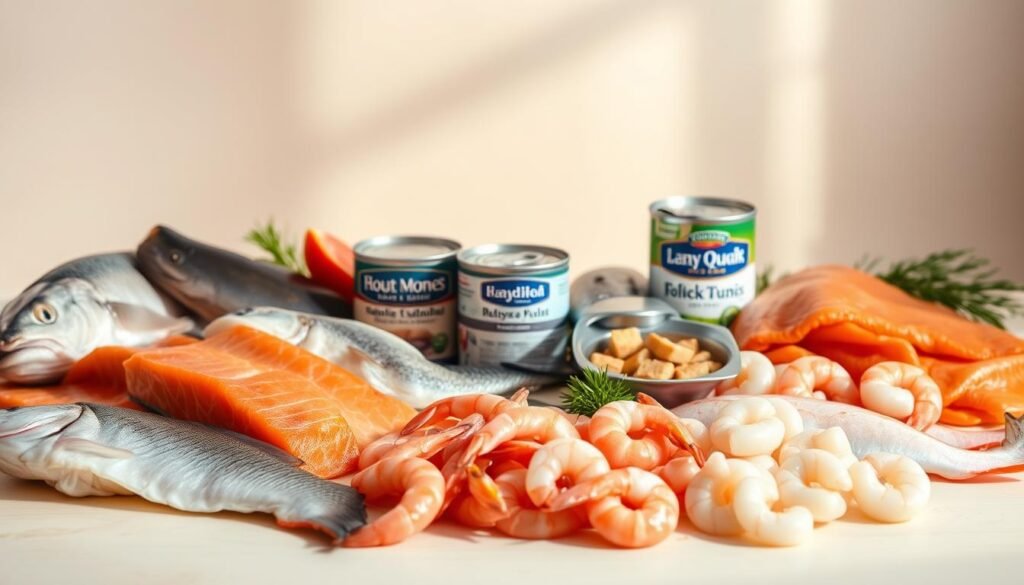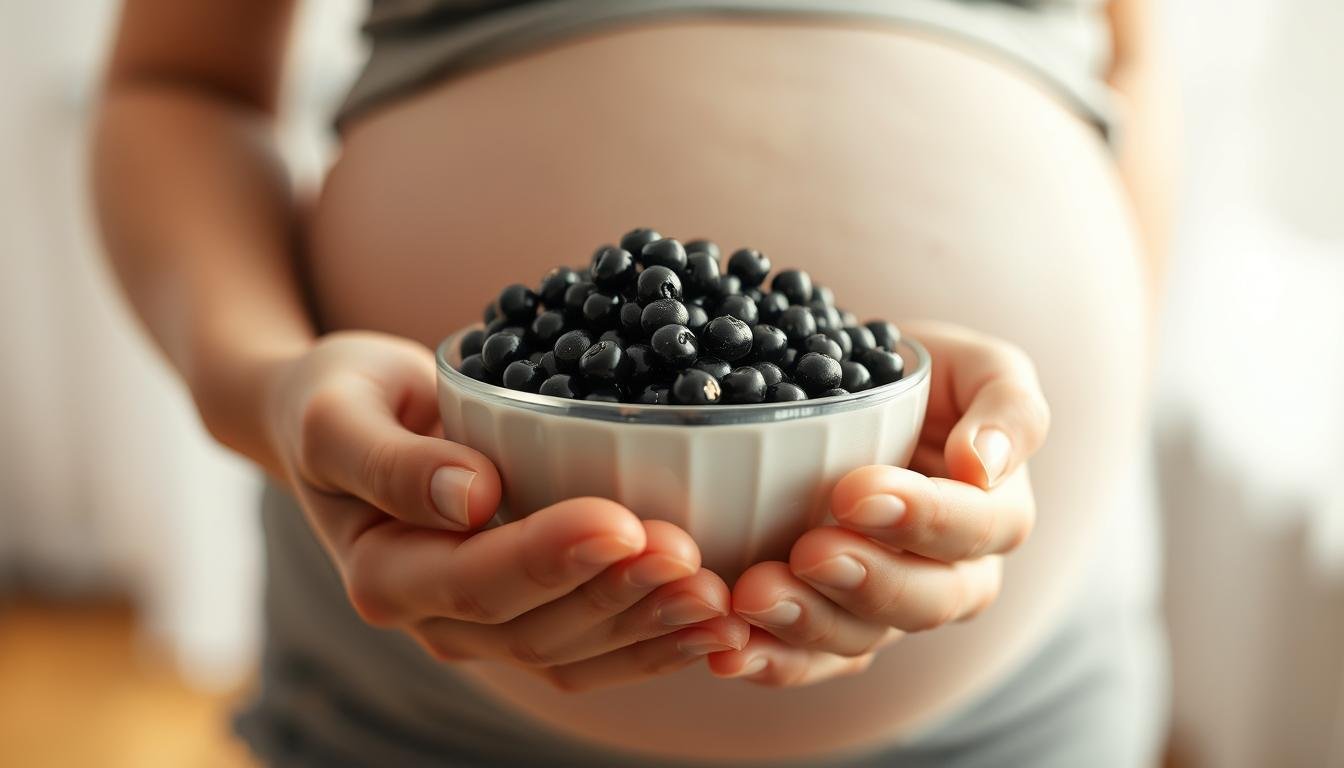Is that luxurious spoonful of caviar safe during pregnancy, or does it hide risks you haven’t considered? Many expecting mothers crave flavorful foods but face confusion about what’s truly safe. While seafood offers nutritional perks, not all options align with prenatal health guidelines.
The NHS doesn’t outright ban caviar for pregnant individuals, but experts emphasize choosing pasteurized varieties to reduce bacterial risks. Raw or underprocessed roe may carry listeria, a harmful bacteria that can affect fetal development. Even with safety measures, some opt to avoid it entirely due to lingering concerns.
Balancing nutrition and caution is key. Caviar provides omega-3s and protein, which support a baby’s brain growth. However, contamination fears often overshadow these benefits. This article explores how it compares to safer fish choices and why moderation matters.
Key Takeaways
- Pasteurized caviar is generally safer during pregnancy than raw options.
- The NHS advises caution with raw seafood to prevent bacterial infections.
- Nutritional benefits like omega-3s must be weighed against contamination risks.
- Many healthcare providers recommend limiting high-risk foods, including some fish roe.
- Always consult a doctor before adding caviar to your prenatal diet.
Understanding Caviar and Its Role During Pregnancy
The journey from fish roe to gourmet caviar involves steps critical for ensuring safety, especially during sensitive times. This delicacy starts as eggs harvested from sturgeon, a type of fish prized for its high-quality roe. Processing methods determine whether it becomes a low-risk food or a potential source of harmful bacteria.
What Is Caviar and How Is It Produced?
Caviar consists of salt-cured eggs from sturgeon, though some varieties use salmon or trout roe. Traditional methods involve lightly salting the eggs to preserve flavor and texture. Modern production often includes pasteurization—a heat treatment that kills pathogens while maintaining quality. Key markers include firm texture, glossy appearance, and airtight packaging.
Pasteurized vs. Unpasteurized Caviar Considerations
Pasteurization is a critical part of safety for those prioritizing low-risk foods. Unpasteurized versions may contain listeria, a bacteria linked to complications in vulnerable groups. Salt curing alone doesn’t eliminate all risks, making heat-treated options safer. Studies show pasteurized varieties reduce foodborne illness data by over 90% compared to raw fish roe.
For children and immunocompromised individuals, these processing differences matter. Always check labels for terms like “heat-treated” or “pasteurized” to ensure safer consumption.
Can Pregnant Women Eat Caviar? A Closer Look
Navigating dietary choices requires extra vigilance when expecting, particularly with gourmet items like caviar. Health organizations emphasize balancing potential benefits against contamination threats. Mercury exposure and bacterial risks dominate expert discussions about fish-based foods during this sensitive period.

Official Recommendations and Professional Insights
The FDA advises limiting mercury intake from seafood to protect fetal development. Pasteurized caviar undergoes heat treatment to eliminate harmful bacteria, making it safer than raw varieties. Unpasteurized roe carries higher risk of listeria contamination, which may impact the nervous system.
Midwives often suggest avoiding high-mercury fish like tuna during early months. While caviar contains less mercury than larger species, portion control remains crucial. Always verify processing methods on labels and consult healthcare providers before consumption.
Contaminant Exposure and Developmental Impacts
Mercury accumulates in aquatic life, posing greater dangers during rapid fetal growth. Even small amounts could affect brain and nerve formation. Studies link prolonged exposure to developmental delays in children.
Salt-cured options might seem safer but don’t neutralize heavy metals. Pairing caviar with low-mercury foods like vegetables helps mitigate risks. Following established guidelines reduces potential harm while allowing occasional indulgences.
Nutritional Considerations for Expecting Mothers
Balanced nutrition becomes a priority for expecting mothers, with seafood offering a wealth of essential nutrients. Fish and other marine products deliver vitamins, minerals, and fatty acids critical for fetal growth. These elements support cellular development and long-term health outcomes.
Essential Nutrients Found in Seafood
Omega-3 fatty acids, like DHA, play a key role in building a baby’s brain and nervous system. Salmon and sardines are popular sources, but fish roe contains concentrated amounts. A single serving provides vitamin B12, iron, and selenium – nutrients that aid red blood cell production and immune function.
Compared to meat, seafood generally has lower saturated fat levels. This makes it a lean protein option for maintaining energy without excess calories. Regular intake aligns with dietary guidelines promoting heart health and cognitive development in children.
How Caviar Compares With Other Protein Sources
Fish eggs pack more omega-3s per ounce than chicken eggs or beef. They also contain antioxidants like vitamin E, which protects cells from damage. While not as common as salmon or tuna, caviar offers a unique combination of acids and proteins in small portions.
Diversifying food choices ensures adequate intake of all essential nutrients. Pairing seafood with leafy greens and whole grains creates meals rich in folate and fiber. This balanced approach supports both maternal well-being and fetal milestones.
Exploring Safer Seafood Choices During Pregnancy
For moms-to-be, navigating the ocean of seafood options means prioritizing low-risk, high-reward choices. The FDA’s updated guidelines highlight low-mercury fish like salmon, sardines, and trout as ideal picks. These options deliver omega-3s and protein while minimizing exposure to harmful contaminants.

Top Picks for Nutrient-Rich Meals
Light tuna (canned in water) offers a budget-friendly option, but limit intake to 2-3 servings per week. Fully cooked shrimp and cod provide versatile alternatives for stir-fries or baked dishes. Avoid raw preparations like sushi unless using heat-treated ingredients.
Creative Alternatives Beyond Fish
Pasteurized caviar can fit into a balanced diet, but explore plant-based proteins like lentils or chia seeds for added variety. Roasted seaweed snacks or avocado toast with smoked salmon offer satisfying crunch without raw risks. Pair these with steamed veggies for folate-rich meals.
Focusing on diversity helps reduce mercury buildup while supporting long-term health for both children and adults. Always cross-check labels and preparation methods to align with safety-first dining during this critical phase.
Guidelines for Consuming Fish and Caviar Safely
Balancing flavor and safety requires smart planning when including seafood in meals. Nutritional authorities emphasize moderation and preparation methods that reduce health risks. Following expert advice helps maintain a balanced diet while protecting vulnerable groups.
Portion Sizes and Serving Recommendations
Limit fish intake to 2-3 servings per week, with each portion around 4 ounces. Pasteurized options from trusted sources lower contamination risks. For families with children, smaller servings (1-2 ounces) help minimize mercury exposure.
Proper Preparation Methods to Minimize Risk
Cook seafood to 145°F internally to kill harmful bacteria. Avoid raw eggs or undercooked dishes like ceviche. Rinse fish under cold water before cooking and store at 40°F or below.
Dietary guidelines recommend pairing seafood with vitamin-C-rich foods to enhance iron absorption. Always discuss consumption habits with a doctor if unsure about portion sizes or safety protocols. Simple adjustments create meals that nourish without compromising health.
Contaminant Concerns: Mercury, Raw Fish, and More
Seafood offers nutritional benefits but brings hidden challenges for those prioritizing safety. Mercury and other contaminants accumulate in marine life, creating risks during critical developmental stages. Recent FDA/EPA data shows over 90% of fish contain trace mercury, making informed choices essential.
Understanding Mercury and Exposure Risks
Mercury binds to proteins in fish, disrupting cell growth in vulnerable groups. Larger species like swordfish and shark have higher mercury levels due to longer lifespans. Even small amounts can impair the nervous system, affecting motor skills and cognitive function in early childhood.
Salmon and sardines rank lowest in mercury content, per FDA charts. Consuming high-risk varieties more than twice a week may exceed safe thresholds. Pregnant individuals should prioritize species with under 0.1 ppm mercury to reduce long-term health impacts.
Strategies to Reduce Contaminants in Your Diet
Trim fat and skin from fish where toxins concentrate. Grill or bake instead of frying to drain excess oils. Pair meals with citrus fruits or bell peppers to boost toxin-flushing antioxidants.
Limit total seafood consumption to 8-12 ounces weekly, rotating between 2-3 low-mercury options. For families with children, serve smaller portions (1-2 ounces) to minimize cumulative exposure. Always verify sourcing and preparation methods when dining out.
Tips for a Balanced Diet During Pregnancy
Building a nutrient-rich plate during pregnancy involves strategic pairing of diverse food groups. Combining fish, fresh produce, and lean proteins creates meals that fuel both mother and baby. This approach ensures adequate vitamin intake while minimizing gaps in essential nutrients.
Smart Pairings for Maximum Nutrition
Grilled salmon with steamed broccoli delivers omega-3s and folate. Add quinoa for complete protein and fiber. Swap red meats with turkey patties twice weekly to reduce saturated fat while maintaining iron levels.
Incorporate leafy greens into smoothies with Greek yogurt for calcium and vitamin K. Snack on apple slices with almond butter or low-fat cheese cubes for sustained energy. These combinations support healthy weight management and fetal development.
Prenatal supplements fill nutritional gaps but shouldn’t replace whole foods. Pair iron-rich spinach with citrus fruits to enhance absorption. Rotate protein sources like eggs, lentils, and white fish throughout the week to maintain variety.
Proper intake of colorful vegetables and antioxidant-rich fruits strengthens immune function. For pregnant women, this balanced diet approach reduces pregnancy complications while supporting optimal baby growth.
Conclusion
Making informed seafood choices during pregnancy requires balancing nutritional benefits with safety precautions. Health authorities like the FDA and NHS stress selecting low-mercury fish and pasteurized products to minimize risks. Prioritizing heat-treated options ensures essential nutrients like fatty acids and vitamins support fetal brain growth without harmful contaminants.
Adhering to portion guidelines—2-3 servings weekly—helps maintain safe mercury intake. Pairing seafood with leafy greens, citrus fruits, and whole grains enhances iron absorption and overall diet quality. Trusted sources, such as certified suppliers, reduce exposure to bacteria or heavy metals.
For those considering specialty items like caviar, opt for pasteurized versions and consult a doctor first. Diversify meals with salmon, shrimp, or plant-based proteins to ensure a variety of nutrients. These strategies promote healthy development while safeguarding maternal and fetal well-being.
Review expert advice and updated safety resources to navigate dietary decisions confidently. Small, mindful adjustments can lead to a nourishing pregnancy journey and a thriving baby.
FAQ
Is pasteurized caviar safer during pregnancy?
Pasteurized caviar undergoes heat treatment to eliminate harmful bacteria, making it a lower-risk option compared to unpasteurized varieties. Always check labels and consult your healthcare provider before including it in your diet.
What nutrients in seafood support fetal growth?
Seafood provides omega-3 fatty acids like DHA, which aid in brain and nervous system development. Vitamin B12, iron, and iodine in fish also promote healthy vision, red blood cell production, and thyroid function for both mother and child.
How does mercury in fish affect pregnancy?
High mercury levels in certain fish can impair a child’s cognitive development and harm the nervous system. Opt for low-mercury options like salmon, cod, or tilapia, and avoid tilefish, swordfish, and king mackerel during these critical months.
Are there safer seafood alternatives to caviar?
Yes. Cooked shrimp, canned light tuna, and wild-caught salmon offer similar nutritional benefits with minimal mercury exposure. Pair these with leafy greens, citrus fruits, or fortified cereals for a balanced meal plan.
What preparation methods reduce contamination risks?
Cook fish to an internal temperature of 145°F (63°C) to kill pathogens. Avoid raw or undercooked dishes like sushi. Rinse produce thoroughly and store meats separately to prevent cross-contamination in your kitchen.
How can a balanced diet support pregnancy health?
Combine lean proteins like poultry or legumes with fiber-rich vegetables and whole grains. Supplements like prenatal vitamins with folic acid fill nutritional gaps, while antioxidants in berries and nuts combat oxidative stress.


